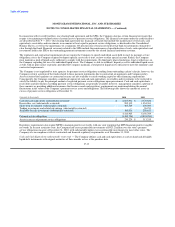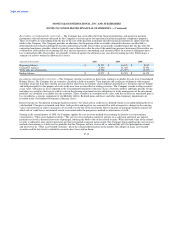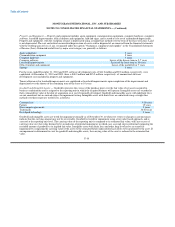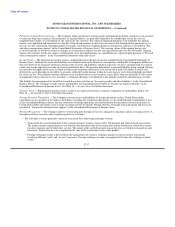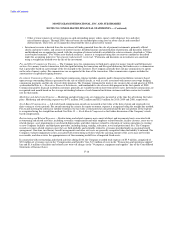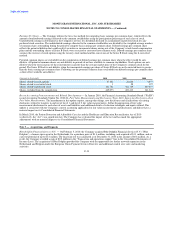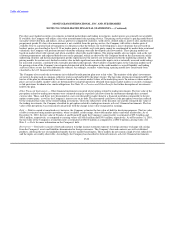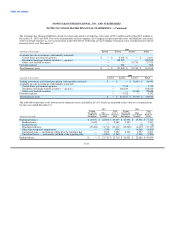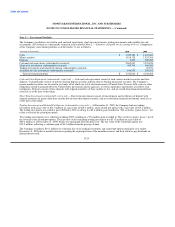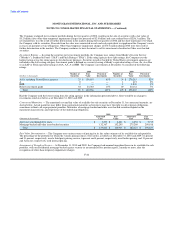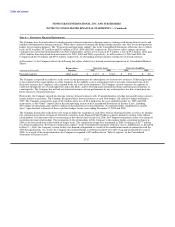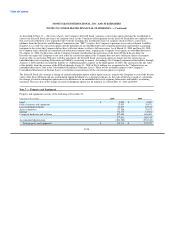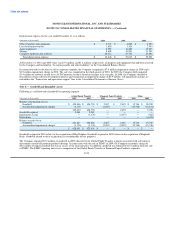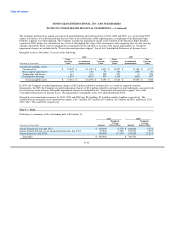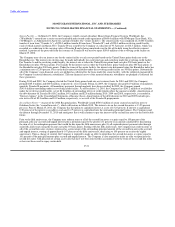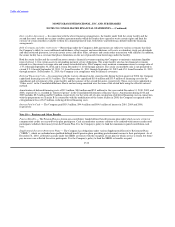MoneyGram 2010 Annual Report Download - page 107
Download and view the complete annual report
Please find page 107 of the 2010 MoneyGram annual report below. You can navigate through the pages in the report by either clicking on the pages listed below, or by using the keyword search tool below to find specific information within the annual report.
Table of Contents
MONEYGRAM INTERNATIONAL, INC. AND SUBSIDIARIES
NOTES TO CONSOLIDATED FINANCIAL STATEMENTS — (Continued)
For other asset-backed securities, investments in limited partnerships and trading investments, market quotes are generally not available.
If available, the Company will utilize a fair value measurement from a pricing service. The pricing service utilizes a pricing model based
on market observable data and indices, such as quotes for comparable securities, yield curves, default indices, interest rates and historical
prepayment speeds. If a fair value measurement is not available from the pricing service, the Company will utilize a broker quote if
available. Due to a general lack of transparency in the process that the brokers use to develop prices, most valuations that are based on
brokers' quotes are classified as Level 3. If no broker quote is available, or if such quote cannot be corroborated by market data or internal
valuations, the Company will perform internal valuations utilizing externally developed cash flow models. These pricing models are
based on market observable spreads and, when available, observable market indices. The pricing models also use inputs such as the rate
of future prepayments and expected default rates on the principal, which are derived by the Company based on the characteristics of the
underlying structure and historical prepayment speeds experienced at the interest rate levels projected for the underlying collateral. The
pricing models for certain asset-backed securities also include significant non-observable inputs such as internally assessed credit ratings
for non-rated securities, combined with externally provided credit spreads. Observability of market inputs to the valuation models used
for pricing certain of the Company's investments deteriorated with the disruption to the credit markets as overall liquidity and trading
activity in these sectors has been substantially reduced. Accordingly, securities valued using a pricing model have consistently been
classified as Level 3 financial instruments.
The Company also records the investments in its defined benefit pension plan trust at fair value. The majority of the plan's investments
are interest-bearing cash or common collective trusts issued and held by the plan's trustee. The fair value of plan investments held by the
trustee of the plan are determined by the trustee based on the current market values of the underlying assets. In instances where market
prices are not available, market values are determined by using bid quotations obtained from major market makers or security exchanges
or bid quotations for identical or similar obligations. See Note 10 — Pension and Other Benefits for further description of investments
held by the plan.
Other Financial Instruments — Other financial instruments consisted of put options related to trading investments. The fair value of the
put options related to trading investments were estimated using the expected cash flows from the instruments through their assumed
exercise date. These cash flows were discounted at a rate corroborated by market data for a financial institution comparable to the put
option counter-party, as well as the Company's interest rate on its debt. The discounted cash flows of the put options were then reduced
by the estimated fair value of the related trading investments. Given the subjectivity of the discount rate and the estimated fair value of
the trading investments, the Company classified its put options related to trading investments as Level 3 financial instruments. The fair
value of the put options was remeasured each period, with the change in fair value recognized in earnings.
Debt — Debt is carried at amortized cost; however, the Company estimates the fair value of debt for disclosure purposes. The fair value
of debt is estimated using market quotations, where available, credit ratings, observable market indices and other market data. As of
December 31, 2010, the fair value of Tranche A and Tranche B under the Company's senior facility is estimated at $95.3 million and
$40.0 million, respectively, as compared to carrying values of $100.0 million and $39.9 million, respectively. As of December 31, 2010,
the fair value of the Company's second lien notes is estimated at $520.0 million as compared to a $500.0 million carrying value. See
Note 9 — Debt for more information on the Company's debt.
Derivatives — Derivatives consist of forward contracts to hedge income statement exposure to foreign currency exchange risk arising
from the Company's assets and liabilities denominated in foreign currencies. The Company's forward contracts are well-established
products, allowing the use of standardized models that use market based inputs. These models do not contain a high level of subjectivity
and the inputs are readily observable. Accordingly, the Company has classified its forward contracts as Level 2 financial instruments.
F-22



